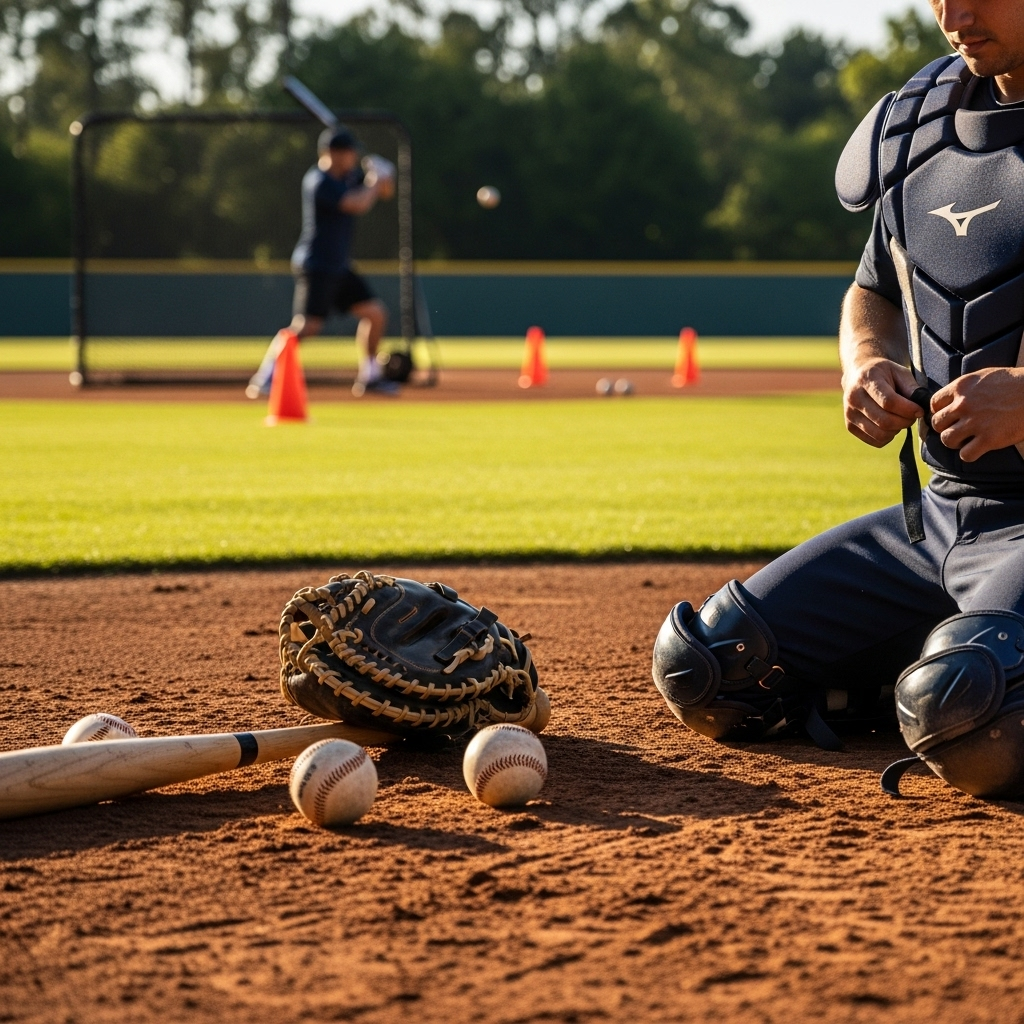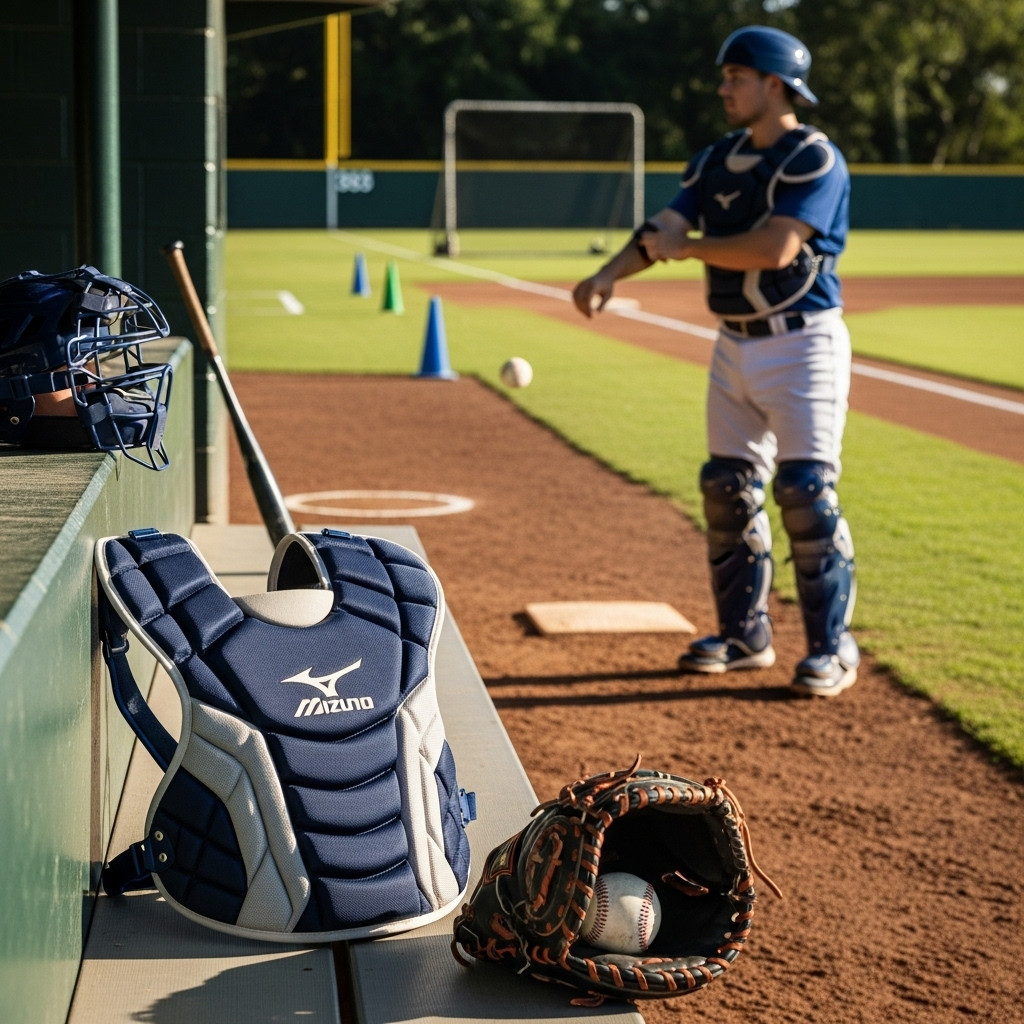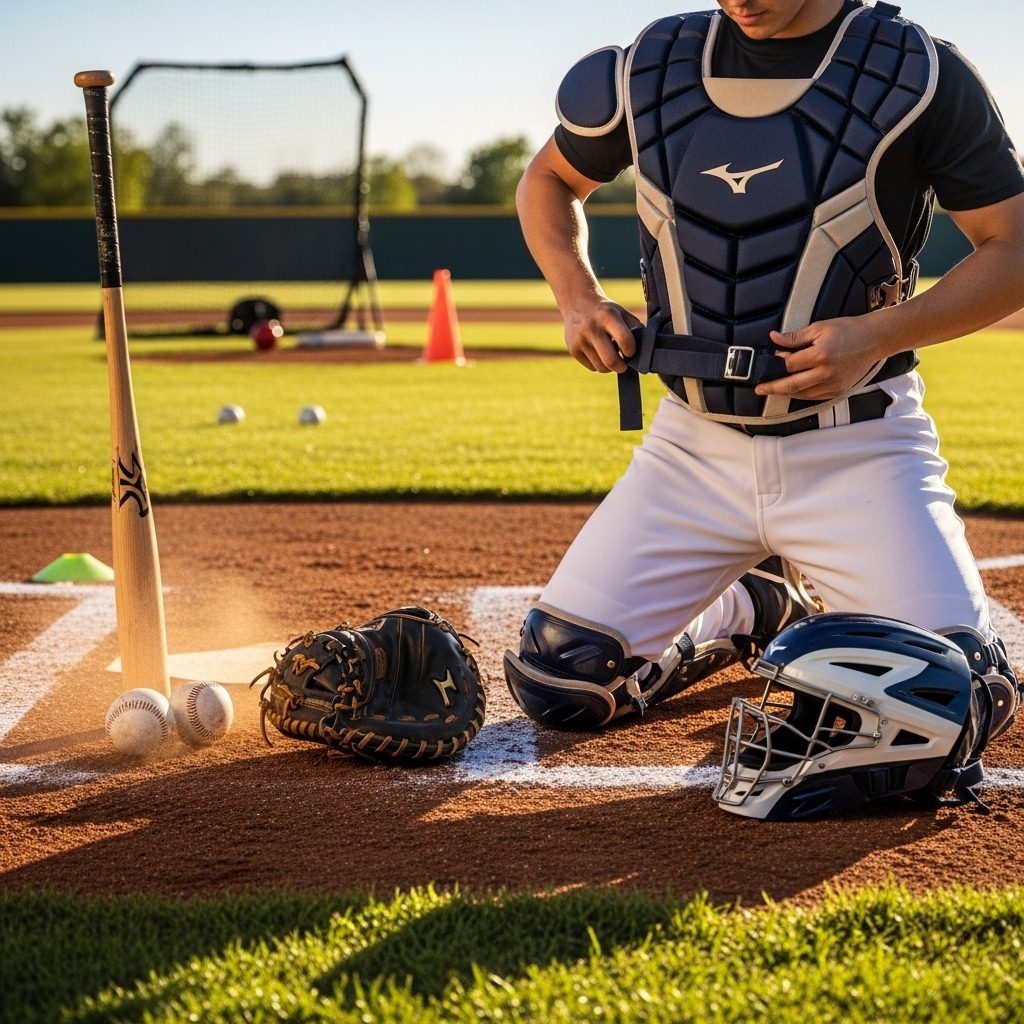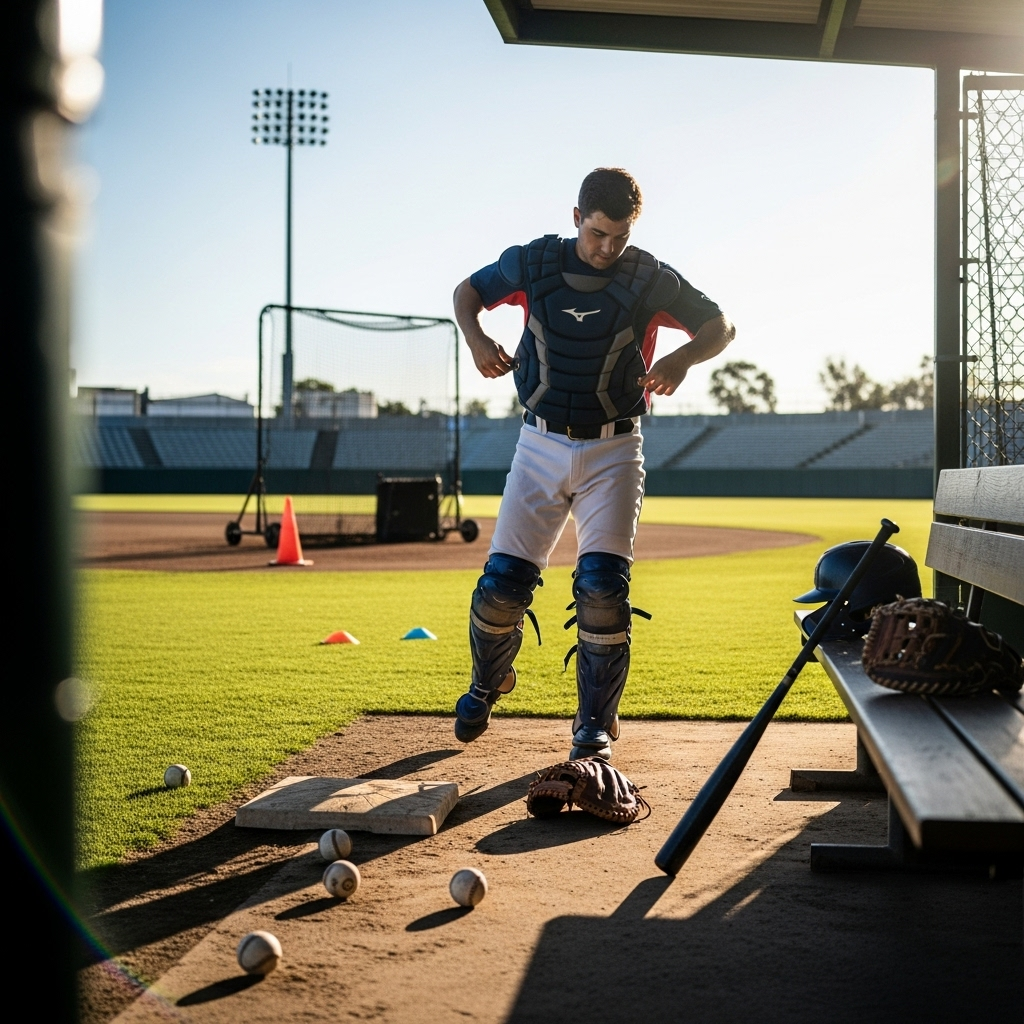Mizuno Catcher’s Chest Protector Buying Guide: The Mizuno catcher’s front protector is top-rated gear for baseball players seeking superior safety and performance. This guide helps beginners choose the best Mizuno protector for maximum protection and comfort.”
Mizuno Catcher’s Protector: Essential Top-Rated Gear for Every Player
Blocking pitches and keeping runners honest at home plate demands confidence. A huge part of that confidence comes from feeling protected. As a catcher, you’re on the front lines, and the right gear is non-negotiable. Many young players and even some seasoned veterans wonder if they’re getting the best protection. If you’ve ever felt a sting through your gear or worried about a foul tip, you’re not alone. We’re here to guide you through selecting a Mizuno catcher’s chest protector, a brand trusted for its quality and innovation. Get ready to feel more secure, play with more focus, and love the game even more.
Why Choose a Mizuno Catcher’s Chest Protector?
Mizuno has a long-standing reputation in the baseball world for crafting high-quality equipment. When it comes to catcher’s gear, they consistently deliver products that blend advanced technology with player comfort. Their chest protectors are designed with the catcher’s specific needs in mind, aiming to provide:
- Superior impact absorption to protect against pitches, foul tips, and collisions.
- Unrestricted movement so you can quickly scoop throws, block pitches, and make plays without feeling encumbered.
- Durability to withstand the rigors of a long season.
- Breathability to help manage heat and sweat during intense games and practices.
For beginners, understanding these benefits is the first step in making an informed decision. You want gear that performs, protects, and helps you develop your skills without distraction.
Understanding Catcher’s Chest Protector Features

Not all chest protectors are created equal. Mizuno offers various models designed for different levels of play and player preferences. Here’s a breakdown of key features to look for:
Materials and Construction
Mizuno typically uses a combination of durable outer shells and high-density foam padding. The outer shell often features plastics like ABS or a proprietary blend that can withstand forceful impacts. Inside, multi-layer foam padding and specialized impact-absorbing technologies work together to spread out the force of a hit, reducing the direct impact on your body. Some higher-end models might incorporate gel inserts or vented foam for added protection and comfort.
Padding and Protection Zones
A good chest protector will have reinforced padding in critical areas: the chest, sternum, and throat. Mizuno often designs these zones with varying densities of foam, with the sternum area typically having the firmest protection. Look for protectors that cover a wide area to offer comprehensive protection from errant pitches and foul tips. Some protectors also feature extended padding down the abdomen, which can be helpful for receiving lower pitches and protecting against body hits.
Fit and Adjustability
A chest protector that doesn’t fit well is not only uncomfortable but can also be less effective. Mizuno protectors usually come with adjustable straps that allow you to customize the fit. These straps are crucial for ensuring the protector stays in place during quick movements and provides optimal coverage. Most models are designed to fit snugly but without restricting your ability to breathe or move your arms and torso.
Ventilation
Catching is a physically demanding position, and staying cool is important for performance and endurance. Many Mizuno chest protectors feature ventilation channels or perforations in the padding to allow for airflow. This helps to dissipate heat and moisture, keeping you more comfortable throughout the game. Look for specific mentions of ventilated designs or breathable materials.
Size Considerations
Chest protectors are typically sized based on a player’s height or age group. It’s essential to consult the sizing chart provided by Mizuno and measure yourself accurately. A protector that is too small won’t offer adequate coverage, while one that is too large can be bulky and shift during play, compromising safety and mobility.
Top Mizuno Catcher’s Chest Protector Models (and Why They’re Great)
Mizuno offers several excellent chest protector options. While specific model numbers can change with product cycles, the principles behind their design remain consistent. Here are some popular types and what makes them stand out:
Mizuno G3 Series (~$100-$150)
The Mizuno G3 series is often a fantastic starting point for youth players and beginners. These protectors are designed to offer a good balance of protection, mobility, and affordability. They typically feature:
- High-density foam padding for solid impact absorption.
- Adjustable straps for a secure, customizable fit.
- A design that allows for essential range of motion.
- Durable construction to hold up for a season or more of regular play.
These are great for players just getting into the catching position or those playing in leagues where high-end equipment may not be a necessity.
Mizuno Samurai Series (~$150-$250)
The Samurai series is a step up, often favored by more competitive youth players, high school athletes, and even some adult league players. They incorporate more advanced technologies for enhanced protection and comfort:
- Triple-layer padding with strategic density for superior impact dispersion.
- Often features Mizuno’s “Black-Suede” lining for a softer, more comfortable feel against the skin and better moisture management.
- A more streamlined design that still allows for excellent mobility.
- Reinforced stitching and materials for increased durability.
- Enhanced ventilation systems to keep players cooler.
The Samurai series is a popular choice for a reason – it offers a significant upgrade in protection without a prohibitive price increase if budget is a factor.
Mizuno Prospect Series (Youth Focus)
The Prospect line is specifically tailored for younger players. These protectors recognize that youth players may not need the same level of robust protection as older athletes, but safety is still paramount. They focus on:
- Lighter weight to avoid overburdening younger players.
- Pads are sized appropriately for smaller frames and chests.
- Easy-to-use adjustment systems for kids (or parents) to manage.
- Good basic protection to build confidence.
Mizuno Pro Series (Advanced/Professional Grade)
For the most serious players, Mizuno offers their Pro gear. These chest protectors are built with the highest standards of protection, durability, and performance. They often include:
- Cutting-edge impact-absorbing technologies (e.g., specific foam compounds, strategic layering).
- Ergonomic designs for maximum freedom of movement.
- Premium materials for superior feel and longevity.
- Often available in more professional colorways.
While these are top-tier, they are generally overkill for beginners unless they are exceptionally serious and have the budget to match.
How to Size Your Mizuno Catcher’s Chest Protector

Getting the right fit is crucial. Here’s how to measure and choose the correct size:
Step 1: Measure Your Height
Stand up straight with your shoes off. Have someone else measure your height from the top of your head down to your feet. This will give you a general idea.
Step 2: Consult the Size Chart
Mizuno provides specific sizing charts for their catcher’s gear. These charts usually correlate height ranges with recommended chest protector sizes (e.g., Youth, Intermediate, Adult). You can typically find these charts on product pages on Mizuno’s website or authorized retailers.
Here is a general guideline, but always refer to the official chart:
| Size | Approximate Height Range |
|---|---|
| Youth Small | 4’0″ – 4’7″ |
| Youth Medium | 4’8″ – 5’2″ |
| Youth Large / Intermediate | 5’3″ – 5’7″ |
| Adult Small/Medium | 5’8″ – 6’0″ |
| Adult Large | 6’1″ and up |
Note: The “Intermediate” size is sometimes a bridge between youth large and adult small, often suitable for developing players or those with a longer torso.
Step 3: Try it On (If Possible)
The best way to ensure a proper fit is to try the chest protector on. If you can’t try it on in person, order from a reputable retailer with a good return policy. Wear a t-shirt similar to what you’d wear during a game. Adjust the straps and move around. Does it feel secure? Can you comfortably bend at the waist and turn your torso? Does it cover your entire chest, sternum, and throat area without gapping?
Step 4: Check for Coverage
When wearing the protector, it should extend from just below your chin (covering the vulnerable throat area) all the way down to your abdomen. It should also extend wide enough to cover your ribs on both sides. Ensure there are no large gaps, especially around the shoulders or sides, where a foul tip could slip through.
How to Properly Wear and Adjust Your Chest Protector
Even the best chest protector won’t work effectively if it’s not worn correctly. Here’s a simple guide:
Step 1: Put on Your Base Layer
Wear a comfortable t-shirt or athletic undershirt. This helps prevent chafing and makes it easier to put on and take off the chest protector.
Step 2: Position the Protector
Place the chest protector over your t-shirt. Ensure the top of the protector is positioned high enough to cover your collarbone and throat area. The sternum pad should be centered over your chest.
Step 3: Connect and Tighten Shoulder Straps
Most Mizuno chest protectors have straps that go over your shoulders and often connect to the sides or back. Adjust these straps so the protector hangs comfortably and securely on your shoulders. It shouldn’t feel like it’s drooping or digging in.
Step 4: Secure the Side/Back Straps
Connect the remaining straps, usually located on the sides or in the back. Tighten these straps firmly. The protector should feel snug against your body, so it doesn’t shift when you move but not so tight that it restricts breathing or flexibility.
Step 5: Test Your Range of Motion
Perform common catcher movements: crouch down, stand up, twist your torso, and swing your arms as if throwing. The chest protector should stay in place, and you should be able to move freely without discomfort.
Step 6: Double-Check Coverage
Visually check in a mirror to ensure complete coverage from your neck down to your stomach and across your ribcage. Make sure there are no awkward gaps.
Caring for Your Mizuno Catcher’s Chest Protector

To get the most life out of your Mizuno gear, proper care is essential. This keeps it safe, functional, and hygienic.
Cleaning
- Spot Clean: For minor dirt and sweat, use a damp cloth with mild soap. Gently wipe down the surfaces.
- Wipe Down Padding: After each use, wipe down the interior padding with a clean, damp cloth. This helps remove sweat and prevent odors.
- Allow to Air Dry: Never put your chest protector in a dryer or expose it to direct high heat, as this can damage the padding and plastics. Always let it air dry completely in a well-ventilated area away from direct sunlight.
- Deep Cleaning (Infrequent): If a deeper clean is needed, you can sometimes remove the padding from the outer shell (check your specific model’s instructions). Hand wash the padding with cool water and mild detergent, then rinse thoroughly and allow to air dry completely before reassembling. The outer shell can be wiped down.
Storage
- Store in a Cool, Dry Place: Avoid storing your chest protector in damp or extremely hot environments, like a car trunk on a hot day.
- Ventilation is Key: If possible, store it in a place where air can circulate around it. A gear bag with mesh panels is ideal.
- Avoid Compression: Don’t store heavy items on top of your chest protector, as this can deform the padding.
Inspection
- Regular Checks: Periodically inspect your chest protector for any signs of wear and tear, such as cracked padding, torn straps, or loose stitching.
- Address Damage: If you find any damage, especially to critical impact zones or straps, it’s important to get it repaired or replaced before your next game or practice to maintain full protection.
Mizuno Catcher’s Chest Protector vs. Other Brands
While Mizuno is a top contender, it’s helpful to know how they stack up against other respected brands. When comparing, consider these factors:
| Feature | Mizuno | Example Competitor A (e.g., All-Star) | Example Competitor B (e.g., Wilson) |
|---|---|---|---|
| Protection Technology | Known for multi-layer foams, often with specific impact dispersion designs. | Often features specialized padding systems (e.g., “KPMG” for shock absorption). | Uses various foams and sometimes gel inserts for cushioning. |
| Fit & Ergonomics | Generally good fit with robust strap systems, designed for mobility. | Often praised for excellent anatomical fit and lower profile designs in higher-end models. | Focus on comfort and flexibility, can vary by model. |
| Durability | Consistently high durability across price points. | Very durable, especially in higher-tier models. | Good durability, but some entry-level models may show wear faster. |
| Ventilation | Good ventilation channels in many models, improving with price. | Often good ventilation, particularly in pro-level gear. | Varies by model; some offer excellent airflow, others are more basic. |
| Price Point | Offers options from beginner-friendly to elite, with competitive pricing. | Similar range, sometimes perceived as slightly higher at the top end. | A wide range, with strong offerings at various price points. |
| Youth Specific Focus | Strong youth lines like Prospect, G3. | Excellent youth options in lines like “System Seven Youth.” | Offers dedicated youth gear with good fit and protection. |
Ultimately, the “best” brand or model often comes down to personal preference regarding feel, fit, and specific features. However, Mizuno consistently ranks high for its blend of protection, performance, and value across its catcher’s gear line.
Safety Beyond the Chest Protector

While a Mizuno chest protector is vital, it’s just one piece of essential catcher’s gear. To be fully protected, you also need:
- Catcher’s Mask/Helmet: Protects your head, face, and jaw. Look for models with good padding and a secure fit. For younger players, a helmet-mask combo is often a great option as it integrates the pieces for younger athletes. Organizations like USA Baseball and Little League have specific regulations on which masks are acceptable
- Catcher’s Mitt: A specialized glove designed for quick transfers and secure catches. It’s typically larger and more heavily padded than a fielder’s glove.
- Leg Guards: These protect your shins, knees, and ankles from foul balls, wild pitches, and impacts with the ground. They should offer good coverage and flexibility.
- Throat Protector (if not integrated): Some masks have built-in throat protection, but others require a separate piece. Ensure this is securely attached if applicable.
- Cup: Essential for male catchers to protect the groin area.
Always ensure all your gear meets league and association safety standards. For official guidelines, you can refer to resources from organizations like Major League Baseball or national youth baseball federations.
Frequently Asked Questions (FAQ)
Q1: What size chest protector do I need?
A: Chest protector sizing is primarily based on your height. Always consult the manufacturer’s specific size chart, which you can usually find on their website or product pages. Measure your height and compare it to the chart to find your appropriate size (e.g., Youth, Intermediate, Adult Small, Medium, Large).
Q2: How tight should a catcher’s chest protector be?
A: It should be snug enough to stay securely
